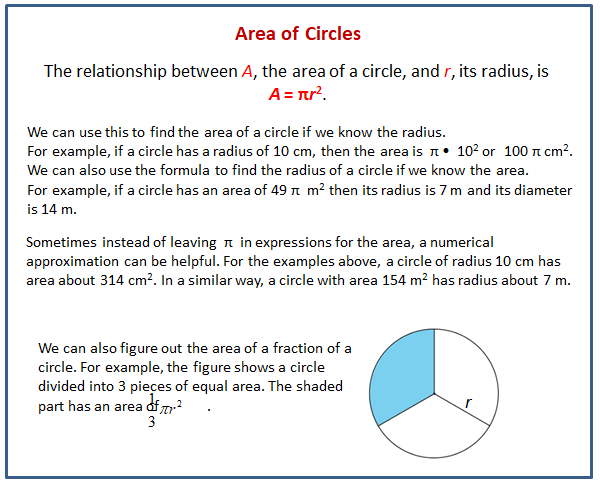Illustrative Mathematics Grade 7, Unit 3, Lesson 9: Applying Area of Circles
Learning Targets:
- I can calculate the area of more complicated shapes that include fractions of circles.
- I can write exact answers in terms of π.
Related Pages
Illustrative Math
Grade 7
Lesson 9: Applying Area of Circles
Let’s find the areas of shapes made up of circles.
Illustrative Math Unit 7.3, Lesson 9 (printable worksheets)
Lesson 9 Summary
The following diagram shows how to relate the area of a circle and its circumference and find the formula for area of a circle.

Lesson 9.1 Still Irrigating the Field
The area of this field is about 500,000 m2. What is the field’s area to the nearest square meter? Assume that the side lengths of the square are exactly 800 m.
A. 502,400 m2
B. 502,640 m2
C. 502,655 m2
D. 502,656 m2
E. 502,857 m2
Lesson 9.2 Comparing Areas Made of Circles
- Each square has a side length of 12 units. Compare the areas of the shaded regions in the 3 figures. Which figure has the largest shaded region? Explain or show your reasoning.
- Each square in Figures D and E has a side length of 1 unit. Compare the area of the two figures. Which figure has more area? How much more? Explain or show your reasoning.
Are you ready for more?
Which figure has a longer perimeter, Figure D or Figure E? How much longer?
Lesson 9.3 The Running Track Revisited
The field inside a running track is made up of a rectangle 84.39 m long and 73 m wide, together with a half-circle at each end. The running lanes are 9.76 m wide all the way around.
What is the area of the running track that goes around the field? Explain or show your reasoning.
Lesson 9 Practice Problems
- A circle with a 12 inch diameter is folded in half and then folded in half again. What is the area of the resulting shape?
- Find the area of the shaded region. Express your answer in terms of π.
- The face of a clock has a circumference of 63 in. What is the area of the face of the clock?
- Which of these pairs of quantities are proportional to each other? For the quantities that are proportional, what is the constant of proportionality?
a. Radius and diameter of a circle
b. Radius and circumference of a circle
c. Radius and area of a circle
d. Diameter and circumference of a circle
e. Diameter and area of a circle - Find the area of this shape in two different ways.
- Elena and Jada both read at a constant rate, but Elena reads more slowly. For every 4 pages that Elena can read, Jada can read 5.
a. Complete the table.
b. Here is an equation for the table: j = 1.25e. What does the 1.25 mean?
c. Write an equation for this relationship that starts e = ….
The Open Up Resources math curriculum is free to download from the Open Up Resources website and is also available from Illustrative Mathematics.
Try the free Mathway calculator and
problem solver below to practice various math topics. Try the given examples, or type in your own
problem and check your answer with the step-by-step explanations.

We welcome your feedback, comments and questions about this site or page. Please submit your feedback or enquiries via our Feedback page.